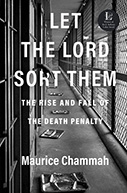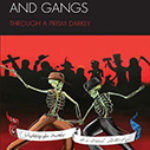Let the Lord Sort Them: The Rise and Fall of the Death Penalty

Author: Maurice Chammah
Publisher: Crown Books, 2021. 368 pages
Reviewer: Carol Steiker ǀ November 2021
Maurice Chammah is a Texas-based journalist and staff writer for The Marshall Project, a Pulitzer-prize-winning news organization that focuses on criminal law and policy, with a progressive, reform-minded approach. Let the Lord Sort Them, Chammah’s first book, is a journalist’s take on the recent history of the death penalty in the state of Texas—ground zero for the American death penalty, responsible for more than a third of the roughly 1,500 executions conducted in the United States over the past 50 years. As his title suggests, Chammah explores the extraordinary rise of the death penalty in Texas in the decades following the U.S. Supreme Court’s revival of capital punishment in 1976, after its temporary invalidation of the practice four years previously, and the equally extraordinary decline in the use of the death penalty starting around 2000 and continuing through the present.
Chammah’s take differs from scholarly approaches to contemporary death penalty issues, such as my own (along with my brother and co-author, Jordan Steiker) in our 2016 book, Courting Death: The Supreme Court and Capital Punishment, or Brandon Garrett’s approach in his 2017 book, End of Its Rope: How Killing the Death Penalty Can Revive Criminal Justice, which I reviewed in these pages. Chammah does not do a deep dive into the constitutional law regulating capital punishment as we did in Courting Death; nor does he conduct empirical studies to attempt to identify the factors that that contributed to the dramatic decline in the death penalty as Garrett did in End of Its Rope. Rather, Chammah brings a journalist’s distinctive cool eye for dispassionate observation and dramatic flair for narrative to the task, with the many benefits as well as the occasional frustrations that such an approach entails. The result is an excellent book that brings a truly extraordinary and unexpected story to life with nuance and color, while refraining from offering opinions or proposing policy changes. Chammah lets his (many!) interviewees do the talking, and readers are left to draw their own conclusions.
Chammah’s portrait of the Texas death penalty’s roller-coaster ride is a crowded tableau, filled with a broad and diverse cast of characters. The story moves kaleidoscopically among prosecutors, prison wardens, executioners, politicians, judges, jurors, defense lawyers, anti-death-penalty advocates, victims and their families, and a panoply of defendants—facing capital charges, living on death row, executed, and exonerated—as well as their families. Chammah conjures vivid images of the courtroom, the Statehouse, the offices of prosecutors and defense lawyers, death row, and the execution chamber, and he sympathetically captures the bereavement and anger of the families of the victims of capital crimes, as well as the stunted and desperate lives of many capital defendants.
Chammah has a great eye for memorable and telling details. For example, he describes how Texas executioners use industrial tape to secure lethal injection IV’s to the arms of the condemned, but then cover it with medical tape “to make it look pretty”—just as lethal injection itself is part of a long line of attempts to dial back the overt cruelty of executions and make them more palatable to the public. Chammah brings home the legacy of the sub-par lawyering all too frequently provided in capital cases in Texas by noting that part of the state’s death row is dubbed the “Mock Wing” after infamously ineffective capital defense lawyer Ronald Mock. On the prosecutorial side, Chammah captures the macho swagger of the Harris County (Houston) District Attorney’s office in the death penalty’s heyday by observing that “Men executed for crimes . . . were referred to as the Silver Needle Society, and several prosecutors started a party band called Death by Injection.” In describing the powerful Harris County District Attorney Johnny Holmes, Chammah details the trappings of his Old West image: “the long handle-bar mustache, the rich drawl, the tobacco pipe, [and] the deer rack and animal hides that lined his office.” Chammah closes a chapter with Holmes commending a young prosecutor on her first death verdict, saying “Congratulations, killer,” and handing her a novelty pen in the shape of a small plastic syringe.
Chammah anchors his sprawling narrative by using two of his characters as a through line, tracking their lives across the surge and decline of the death penalty in Texas. One of those characters is the recipient of Johnny Holmes’ syringe/pen—Elsa Alcala, whose trajectory neatly mirrors the change in the Texas death penalty. Orphaned as a young teen in a Mexican-American family, Alcala has had an extraordinary career in criminal justice, first as a prosecutor in Holmes’ macho office and later as an elected Republican judge who rose to sit on the highest criminal court in Texas, the Court of Criminal Appeals (CCA). Over time, Alcala’s reservations about the Texas death penalty grew, and she expressed them in a series of dissents addressing such problems as the ineffectiveness of capital defense counsel, the imposition of the death penalty on defendants with intellectual disability, and the influence of race on the capital sentencing process. Several of Alcala’s dissents were vindicated by reversals of the CCA by the none-too-liberal U.S. Supreme Court. Alcala’s engagement with the death penalty came full circle when, after her retirement from the CCA, she joined the Texas Defender Service in a policy role, advocating for death penalty reform in the Texas legislature—a very unusual defection of a former capital prosecutor to a capital defense organization.
The other through-line character is Danalynn Recer, a Houston native and University of Texas graduate who became a passionate, dyed-in-the-wool capital defender. Recer’s career path was set while she was writing her history master’s thesis on lynchings in the state of Texas, while simultaneously pursuing a law degree. Out of the blue, Recer was contacted by lawyers from the Texas Resource Center, a capital defense organization that was defending a black man sentenced to death by an all-white jury for shooting a white man, who thought Recer’s research might help their case. Recer was captivated by their cause; as she put it, “I ran away with the circus.” Recer soon became something of a ringmaster herself, founding an organization called the Gulf Region Advocacy Center (GRACE) in Houston, which operated on a shoe-string budget while working tirelessly for capital clients.
Recer’s career illustrates one of the substantial drivers of the death penalty’s decline in Texas—the rise of mitigation advocacy, by which capital defense lawyers exhaustively explore every aspect of the lives of their clients to find evidence to present to sentencing juries that might call forth a sentence of life rather than death. As Chammah colorfully puts it, lawyers become “biographer, ethnographer, therapist, and friend” to their clients in the pursuit of mitigating evidence. Recer’s tiny “bakesale justice” organization was catapulted to national prominence when she won an unexpected life verdict for capital defendant Juan Quintero, a Mexican immigrant who had shot and killed a police officer, after Recer presented extensive evidence about Quintero’s abused childhood, brain damage, and mental illness. Following that verdict, Recer was profiled by Jeffrey Toobin in a 2011 New Yorker piece entitled “The Mitigator” and subtitled “A new way of looking at the death penalty.”
While mitigation in capital trials was neither new in 2011 nor pioneered by Recer, capital representation had indeed evolved through the work of a nationwide network of capital defense organizations, including GRACE, that set new standards for what was expected—and effective—in capital sentencing trials. Quintero’s case was a good example of what masterful representation could do in a difficult case that almost certainly would have yielded a death sentence under the conditions prevailing only a decade or two earlier. Chammah uses other cases to illustrate some of the other changing circumstances that contributed to the decline of the death penalty in Texas. The cases of Henry Lee Lucas, Gary Graham, and Todd Willingham all illustrate new concerns about the possibility of executing innocent people based on false confessions, faulty identification testimony, or junk science. The case of the three white supremacists convicted of the truck-dragging murder of James Byrd, Jr., illustrates the sky-rocketing cost of capital prosecutions; the small county in which the case was tried had to increase its tax rate nearly 12 percent to cover the cost of the trials for that single murder. The plea deal to a life sentence offered to Francisco Castellano illustrates the power of a sentence of life without parole, introduced in Texas in 2005, as an alternative to the death penalty and a powerful bargaining chip in the prosecutor’s pocket.
Chammah’s choice to cover these changing circumstances through individual cases has several advantages. The cases bring to life the practical implications of otherwise dry abstractions like mitigation, wrongful convictions, capital defense funding, and life-without-parole sentences. The cases are deftly woven into a narrative that is built around the two main protagonists. And the narrative approach certainly makes for non-tendentious and engaging reading. But Chammah’s storytelling can occasionally be frustrating, too. Although Chammah often seems sympathetic to critics of the death penalty, he also includes details that are not always flattering to that cause, for example when Danalynn Recer is publicly called out by a critic for selling “murderabilia”—t-shirts with art created by Juan Quintero—as a form of fundraising for GRACE. Some readers may yearn for the author to say what he makes of all this—to take a moral or political position, or suggest some possible policy changes that might improve things, or try to assess the relative significance of some changes versus others to the death penalty’s decline—rather than pile story upon story and contrasting quote upon contrasting quote.
Ultimately, Chammah lets his interviewees do the talking and leaves it to his readers to make the assessments. Perhaps this is fitting, as the book’s clearest message is that the death penalty is a creature of politics—our creature, our politics—so its fate lies in the hands of informed voters. Chammah’s book will go far to helping its readers understand the death penalty’s recent past and chart it future.
Carol S. Steiker, Henry J. Friendly Professor of Law, Harvard Law School


